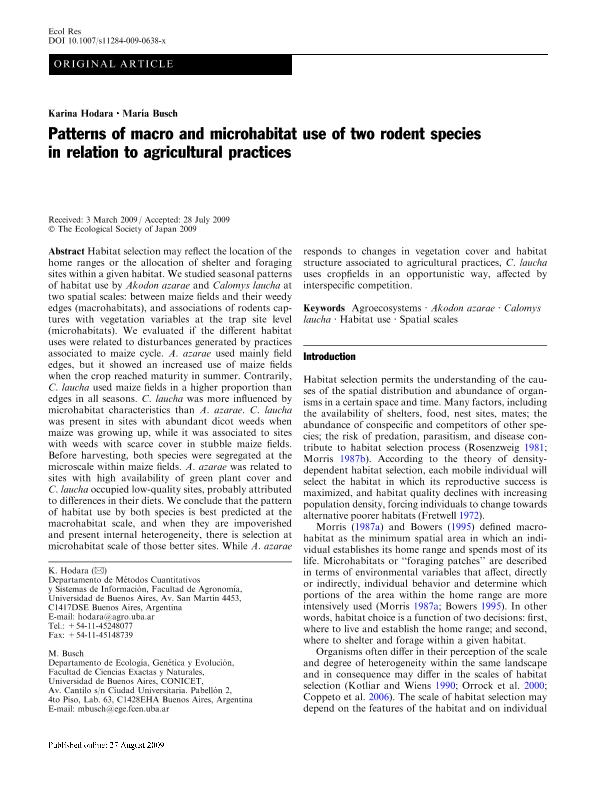Mostrar el registro sencillo del ítem
dc.contributor.author
Hodara, Karina

dc.contributor.author
Busch, Maria

dc.date.available
2019-01-25T17:22:23Z
dc.date.issued
2010-01
dc.identifier.citation
Hodara, Karina; Busch, Maria; Patterns of macro and microhabitat use of two rodent species in relation to agricultural practices; Wiley; Ecological Research; 25; 1; 1-2010; 113-121
dc.identifier.issn
0912-3814
dc.identifier.uri
http://hdl.handle.net/11336/68625
dc.description.abstract
Habitat selection may reflect the location of the home ranges or the allocation of shelter and foraging sites within a given habitat. We studied seasonal patterns of habitat use by Akodon azarae and Calomys laucha at two spatial scales: between maize fields and their weedy edges (macrohabitats), and associations of rodents captures with vegetation variables at the trap site level (microhabitats). We evaluated if the different habitat uses were related to disturbances generated by practices associated to maize cycle. A. azarae used mainly field edges, but it showed an increased use of maize fields when the crop reached maturity in summer. Contrarily, C. laucha used maize fields in a higher proportion than edges in all seasons. C. laucha was more influenced by microhabitat characteristics than A. azarae. C. laucha was present in sites with abundant dicot weeds when maize was growing up, while it was associated to sites with weeds with scarce cover in stubble maize fields. Before harvesting, both species were segregated at the microscale within maize fields. A. azarae was related to sites with high availability of green plant cover and C. laucha occupied low-quality sites, probably attributed to differences in their diets. We conclude that the pattern of habitat use by both species is best predicted at the macrohabitat scale, and when they are impoverished and present internal heterogeneity, there is selection at microhabitat scale of those better sites. While A. azarae responds to changes in vegetation cover and habitat structure associated to agricultural practices, C. laucha uses cropfields in an opportunistic way, affected by interspecific competition.
dc.format
application/pdf
dc.language.iso
eng
dc.publisher
Wiley

dc.rights
info:eu-repo/semantics/openAccess
dc.rights.uri
https://creativecommons.org/licenses/by-nc-sa/2.5/ar/
dc.subject
Agroecosystems
dc.subject
Akodon Azarae
dc.subject
Calomys Laucha
dc.subject
Habitat Use
dc.subject
Spatial Scales
dc.subject.classification
Otras Ciencias Biológicas

dc.subject.classification
Ciencias Biológicas

dc.subject.classification
CIENCIAS NATURALES Y EXACTAS

dc.title
Patterns of macro and microhabitat use of two rodent species in relation to agricultural practices
dc.type
info:eu-repo/semantics/article
dc.type
info:ar-repo/semantics/artículo
dc.type
info:eu-repo/semantics/publishedVersion
dc.date.updated
2019-01-25T13:43:13Z
dc.journal.volume
25
dc.journal.number
1
dc.journal.pagination
113-121
dc.journal.pais
Estados Unidos

dc.description.fil
Fil: Hodara, Karina. Universidad de Buenos Aires. Facultad de Agronomía. Departamento de Métodos Cuantitativos y Sistemas de Información; Argentina. Consejo Nacional de Investigaciones Científicas y Técnicas; Argentina
dc.description.fil
Fil: Busch, Maria. Universidad de Buenos Aires. Facultad de Ciencias Exactas y Naturales. Departamento de Ecología, Genética y Evolución; Argentina. Consejo Nacional de Investigaciones Científicas y Técnicas; Argentina
dc.journal.title
Ecological Research

dc.relation.alternativeid
info:eu-repo/semantics/altIdentifier/doi/http://dx.doi.org/10.1007/s11284-009-0638-x
dc.relation.alternativeid
info:eu-repo/semantics/altIdentifier/url/https://onlinelibrary.wiley.com/doi/abs/10.1007/s11284-009-0638-x
Archivos asociados
